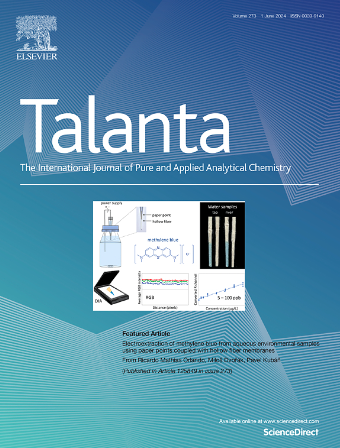Bifunctional Fe-CDs@MOF composite nanozyme based ratiometric fluorescent probe for the detection of xanthine in fish
IF 5.6
1区 化学
Q1 CHEMISTRY, ANALYTICAL
引用次数: 0
Abstract
A novel bifunctional Fe-CDs@MOF composite nanozyme was synthesized successfully by loading Fe doped carbon dots (Fe-CDs) onto metal-organic framework (MOF) MIL-101 (Fe). The introduction of Fe-CDs enhanced the peroxidase (POD)-like activity of MOF and endowed it with excellent fluorescence properties. Considering the dual functions of Fe-CDs@MOF, we combined it with o-phenylenediamine (OPD)/xanthine oxidase (XOD) to construct a ratiomeric fluorescence probe for xanthine (XAN) detection. XAN was first oxidized by XOD to produce H2O2, then Fe-CDs@MOF exerted its POD-like activity to catalyze the reaction between OPD and H2O2 to form 2,3-diaminophenazine (DAP). DAP in turn quenched the fluorescence of Fe-CDs@MOF as a result of internal filtration effect. The ratio of the fluorescence intensity of DAP and the fluorescence intensity of Fe-CDs@MOF indicated the XAN content. The XAN detection range was 1–100 μM with a limit of detection of 0.36 μM. The ratiometric fluorescence probe was utilized to analyze XAN in fish samples, and the results obtained were in good agreement with those assayed by high performance liquid chromatography. The method also had the ability to test the freshness of frozen fish. This study provides a novel approach for the design and application of Fe-CDs@MOF composite nanozyme.

求助全文
约1分钟内获得全文
求助全文
来源期刊

Talanta
化学-分析化学
CiteScore
12.30
自引率
4.90%
发文量
861
审稿时长
29 days
期刊介绍:
Talanta provides a forum for the publication of original research papers, short communications, and critical reviews in all branches of pure and applied analytical chemistry. Papers are evaluated based on established guidelines, including the fundamental nature of the study, scientific novelty, substantial improvement or advantage over existing technology or methods, and demonstrated analytical applicability. Original research papers on fundamental studies, and on novel sensor and instrumentation developments, are encouraged. Novel or improved applications in areas such as clinical and biological chemistry, environmental analysis, geochemistry, materials science and engineering, and analytical platforms for omics development are welcome.
Analytical performance of methods should be determined, including interference and matrix effects, and methods should be validated by comparison with a standard method, or analysis of a certified reference material. Simple spiking recoveries may not be sufficient. The developed method should especially comprise information on selectivity, sensitivity, detection limits, accuracy, and reliability. However, applying official validation or robustness studies to a routine method or technique does not necessarily constitute novelty. Proper statistical treatment of the data should be provided. Relevant literature should be cited, including related publications by the authors, and authors should discuss how their proposed methodology compares with previously reported methods.
 求助内容:
求助内容: 应助结果提醒方式:
应助结果提醒方式:


